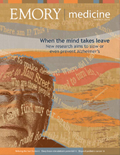Heart's fat layer may help predict disease
 |
The amount of fat around the heart can provide useful clues to help determine the need for further testing for heart disease, particularly compared with standard diagnostic tests such as coronary artery calcium scoring.
The standard coronary artery calcium scoring shows the location and extent of calcified plaque in the coronary artery, but Emory researchers are learning that it’s the non-calcified plaques that indicate trouble. They found that fat tissue was highest in patients with non-calcified plaques. Fat tissue around the heart is of concern because it secretes relatively large amounts of inflammatory hormones.
“Release of inflammatory factors from the fat tissue around the heart may be promoting an active atherosclerotic process, and this is indicated by the presence of non-calcified plaques,” says Paolo Raggi, director of Emory’s cardiac imaging center.
Though the heart’s overall coronary calcium buildup is a good predictor of heart disease, calcium in an individual plaque doesn’t necessarily mean imminent trouble, Raggi says.
A CT or MRI can measure the volume of fat around the heart. “This information can be used as a ‘gatekeeper,’ in that it could help a cardiologist decide whether a patient should have a nuclear stress test,” he says.
In another Emory study, fat tissue around the heart was measured in patients receiving a nuclear stress test. These patients had chest pain but were not known to have heart disease. The nuclear stress test showed that ischemia correlated more closely with the volume of fat tissue around the heart than with the coronary calcium score.


